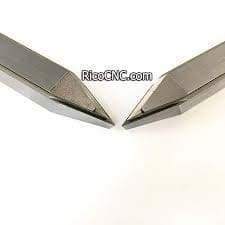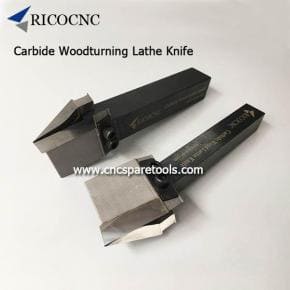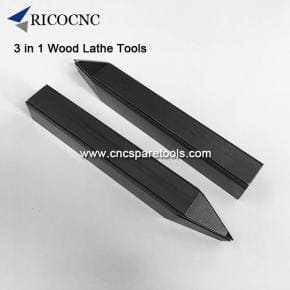Wood lathes are fascinating tools that allow craftsmen to create beautiful, intricate pieces from raw wood. At the heart of this craft are the wood lathe knives, also known as turning tools. This comprehensive guide will explore how to use wood lathe knives effectively, helping both beginners and experienced woodturners refine their skills and create stunning projects. Whether you're just starting out or looking to enhance your technique, this article will provide valuable insights into the world of woodturning.
Wood lathe knives, or turning tools, are the essential implements used in woodturning to shape and cut wood as it rotates on a lathe. These tools come in various shapes and sizes, each designed for specific tasks in the turning process.The importance of wood lathe knives cannot be overstated:
-They allow for precise control over the shape and texture of the wood
-Different types of knives enable various cutting techniques
-Proper use of lathe knives ensures safety and efficiency in woodturning
Understanding how to use these tools effectively is crucial for anyone looking to master the art of woodturning.
When it comes to woodturning, there's a wide array of tools at your disposal. Let's explore some of the most common types of wood lathe knives:
1.Roughing gouge: Used for initial shaping of spindles
2.Spindle gouge: For detailed work on spindles and bowls
3.Bowl gouge: Specifically designed for turning bowls and hollow forms
4.Parting tool: Used to create grooves and separate pieces
5.Scraper: For smoothing and finishing surfaces
6.Skew chisel: A versatile tool for creating smooth, flat surfaces and beads
Each of these tools has its unique characteristics and applications in woodturning. As you gain experience, you'll develop preferences for certain tools based on your turning style and the projects you undertake.

Selecting the appropriate wood lathe knife is crucial for achieving the desired results in your woodturning project. Here are some factors to consider:
-Project type: Are you turning a bowl, spindle, or something else?
-Wood species: Harder woods may require different tools than softer woods
-Desired finish: Some tools are better suited for rough shaping, while others excel at fine detail work
-Your skill level: Certain tools may be more challenging to use for beginners
Remember, as you gain experience, you'll develop a better understanding of which tools work best for different situations. Don't be afraid to experiment with various knives to find what works best for you.
Mastering the basic techniques of using wood lathe knives is essential for successful woodturning. Here are some fundamental skills to practice:
1.Tool presentation: Hold the tool firmly against the tool rest at the correct angle
2.Bevel rubbing: Allow the bevel of the tool to glide along the wood surface
3.Cutting action: Gradually raise the handle to engage the cutting edge
4.Smooth motion: Move the tool steadily along the workpiece for even cuts
It's important to start with these basics and gradually build up to more advanced techniques. Practice on scrap wood before moving on to your actual projects to gain confidence and improve your skills.
Keeping your wood lathe knives sharp is crucial for clean cuts and safe operation. Here's a basic guide to sharpening your tools:
1.Use a bench grinder or sharpening stone
2.Maintain the correct bevel angle for each tool
3.Use light pressure to avoid overheating the metal
4.Finish with a honing stone for a razor-sharp edge
Regular sharpening will not only improve the quality of your work but also make turning safer and more enjoyable.
Safety should always be your top priority when working with wood lathe knives. Here are some essential safety tips:
-Wear appropriate personal protective equipment (PPE), including safety glasses and a face shield
-Ensure your tools are sharp and in good condition
-Keep your work area clean and free of clutter
-Never force a cut or use excessive pressure
-Always turn off the lathe before adjusting your work or tools
By following these safety guidelines, you can minimize the risk of accidents and enjoy woodturning with peace of mind.

Improving your skills with wood lathe knives takes time and practice. Here are some tips to help you progress:
1.Start with simple projects and gradually increase complexity
2.Practice regularly, even if it's just for short periods
3.Watch tutorials and demonstrations from experienced turners
4.Join a local woodturning club or take classes
5.Experiment with different tools and techniques
Remember, every experienced woodturner was once a beginner. Patience and persistence are key to developing your skills.
Even experienced woodturners can make mistakes. Here are some common errors to watch out for:
-Using dull tools
-Applying too much pressure
-Incorrect tool presentation angle
-Neglecting proper safety precautions
-Rushing through projects
By being aware of these potential pitfalls, you can take steps to avoid them and improve the quality of your work.
Proper maintenance of your wood lathe knives is essential for their longevity and performance. Here are some tips:
1.Clean tools after each use
2.Store tools in a dry place to prevent rust
3.Regularly inspect tools for damage or wear
4.Sharpen tools as needed
5.Apply a light coat of oil to prevent rust on carbon steel tools
With proper care, your wood lathe knives can last for many years, providing you with countless hours of enjoyable woodturning.

As you become more comfortable with basic woodturning techniques, you may want to explore more advanced methods. Some advanced techniques include:
-Hollow form turning
-Multi-axis turning
-Texturing and embellishment
-Thin-wall turning
-Segmented turning
These techniques can open up new possibilities for your woodturning projects and help you create truly unique pieces.
-Wood lathe knives are essential tools for woodturning, each with specific uses and techniques
-Choosing the right tool for your project is crucial for success
-Proper sharpening and maintenance of your tools is vital for safety and quality results
-Safety should always be your top priority when using wood lathe knives
-Improving your skills takes time, practice, and patience
-Advanced techniques can expand your woodturning capabilities and creativity
By mastering the use of wood lathe knives, you'll be well on your way to creating beautiful, intricate woodturned pieces. Remember to always prioritize safety, maintain your tools, and enjoy the learning process as you develop your skills in this rewarding craft.
Contact: RicoCNC
Phone: 0086-13390848665
E-mail: cncsale@ricocnc.com
Whatsapp:0086-15264185266
Add: NO. 60, Weixin Road, Industrial Park, Suzhou, Jiangsu, China, 215000
We chat
